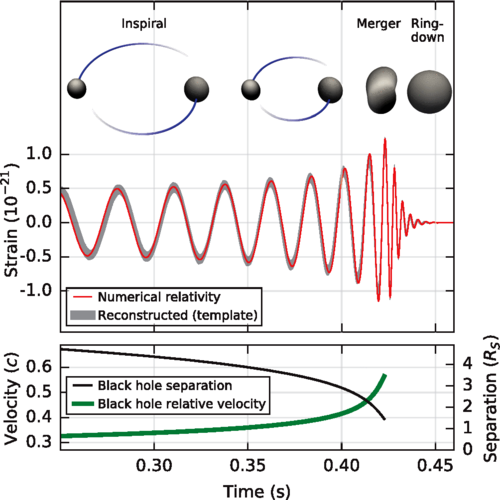Paper of the month: First direct observation of Gravitational Waves from a Binary Black Hole Merger

On September 14, 2015 at 11:50 a.m. Central European Time the two detectors of the Laser Interferometer Gravitational-Wave Observatory (LIGO) simultaneously observed a gravitational-wave signal, shown in Fig 1. This epic and historical discovery was an-nounced last week, on Thursday 11, 2016.
February 26, 2016 by tiinatimonen
Gravitational waves were first predicted to exist by Albert Einstein one century ago. These waves travel at the speed of light and they are generated by any mass acceleration that is not spherically or cylindrically symmetric. For instance, they can be produced by the merger of two astrophysical objects like black holes or neutron stars. However, the gravitational-wave amplitude would be remarkably small by the time they reach the Earth, making their detection exceptionally hard. Indeed, these waves can make the length of the LIGO detector shorter and longer by an incredibly minute amount: even the strongest gravitational waves expected from astrophysical events would pro-duce relative length variations which are less than one part in a billion trillion. In 1916, Schwarzschild published a solution for the field equations that was later un-derstood to describe a black hole. Further studies and theories have enabled modeling of binary black hole mergers and giving accurate predictions of their gravitational waves. While numerous black hole candidates have been identified through electromagnetic observations, black hole mergers have not previously been observed.
Figure 1.

The indirect observation of gravitational waves for the first time was done in 1974 by physicists Joseph Taylor and Russell Hulse, whose study was acknowledged by the Nobel Prize in Physics in 1993. They measured the period of radio flashes emitted by a pair of pulsars (radiating neutron stars) whirling around one another. The change of the period of flashes has been perfectly described by emission of gravitational waves in total agreement with the prediction of general relativity.
Figure 2.

A century after the theoretical predictions of Einstein and Schwarzschild, LIGO has re-ported the first direct detection of gravitational waves. They observed two black wholes with correspondent masses of 36 and 29 solar masses merging together and releasing the energy equivalent to three solar masses in form of gravitational waves only. This is more than ten times larger than the combined light power of every star in the observable Universe! The observation is depicted in Fig. 1. The top panels show the measured signal in the Hanford (top left) and Livingston (top right) detectors. The central panels show the expected signal produced by the merger of two black holes, based on numerical simulations. The bottom panels show a time-frequency representation of the strain data, showing the signal frequency increasing over time.
Figure 3.

Fig. 3 shows how to interpret the observed signal. During the first part of the signal, both black holes rotate around their common center of mass and fall in a spiral towards each other. Their event horizons merge, forming a single black hole – it is its event horizon that vibrates, generating the higher frequency gravitational waves. Eventually, these vibrations stop, and all that is left is a single rotating black hole.
The gravitational waves detected by LIGO have also been converted to sound waves, as you can listen here: https://www.youtube.com/watch?v=egfBaUdnAyQ. In the first two runs of the animation, the sound-wave frequencies exactly match the frequencies of the gravitational waves. The second two runs of the animation play the sounds again at higher frequencies that better fit the human hearing range. As the black holes spiral closer and closer, the frequency of the gravitational waves increases.
In order to be sure that the signal corresponds to a real gravitational wave, the LIGO experiment uses two twin detectors separated by 3030 km. Both LIGO detectors have identical design of L-shaped interferometers with 4 km long arms. The 808 nm beam of near-infrared laser light is split into two beams and sent into the arms, where reflected by mirrors they come back to sum up and for an interference picture. The gravitational wave passing through the detector causes relative changes of length of the arms, therefore distorting the interference. LIGO’s engineers have managed to reach astonishing sensi-tivity: the setup is able to detect length differences of the order of 1/10,000th the width of a proton. In comparison with LIGO's size, that's like detecting a hair’s-width change in the distance from the Sun to Alpha Centauri!
LIGO’s discovery puts on a solid ground the new emergent brunch of observational as-tronomy — gravitational wave astronomy, which is complementary to many other ways of looking at the universe.
Other gravitational wave detectors - such as the Virgo interferometer near Pisa, Italy, and the GEO600 interferometer near Hannover, were not operating at the time of LIGO’s observation and so could not confirm the signal. However, these detectors, together with other upcoming Earth-based detectors, such as Advanced Virgo, KAGRA in Japan, and possibly a third LIGO detector in India will further enlarge the global gravitational wave detector network. In the future, eLISA, a space-based interferometer, will enable us to peer deeper into the cosmos than ground-based detectors, allowing studies of the for-mation of the most massive astrophysical objects and maybe even understanding infla-tion.
Gravitational wave detection will allow new and more precise measurements of astro-physical sources. This early discovery made by LIGO means that black hole mergers will be observed quite often with the current version of the LIGO detector (Advanced LI-GO), which will be further improved over the next few years. Gravitational wave astron-omy will hopefully help us understanding more about black holes, neutron stars and oth-er massive astrophysical objects. Perhaps it will also help explaining some unresolved questions in astrophysics, such as gamma-ray bursts and give us more insight on the evolution of the early universe.
References:
• https://www.ligo.caltech.edu/news/ligo20160211
• https://journals.aps.org/prl/pdf/10.1103/PhysRevLett.116.061102
• http://www.nature.com/news/einstein-s-gravitational-waves-found-at-last-1.19361
• https://www.youtube.com/watch?v=egfBaUdnAyQ
• http://mediaassets.caltech.edu/gwave
Text by Valerie Domcke, Ignacio Hierro and Kirill Kanshin




